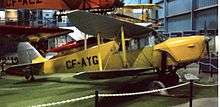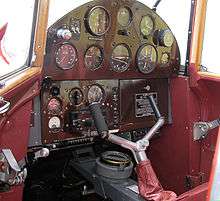de Havilland Hornet Moth
| DH.87 Hornet Moth | |
|---|---|
 | |
| 1936 de Havilland DH87B Hornet Moth | |
| Role | Trainer and Tourer |
| Manufacturer | de Havilland |
| First flight | 9 May 1934 |
| Status | still in operation |
| Primary user | private owner pilots |
| Produced | 1935–1938 |
| Number built | 164 |
|
| |
The de Havilland DH.87 Hornet Moth is a single-engined cabin biplane designed by the de Havilland Aircraft Company in 1934 as a potential replacement for its highly successful de Havilland Tiger Moth trainer. Although its side-by-side two-seat cabin made it closer in configuration to the modern aircraft that military trainee pilots would later fly, there was no interest from the RAF and the aircraft was put into production for private buyers.
Design and development

The prototype first flew at Hatfield on 9 May 1934 and, with two other pre-production aircraft, embarked on an extensive test program that resulted in the first production aircraft (designated DH.87A) completed in August 1935 having wings of greater outboard taper. These were found to cause problems, especially when landing in three-point attitude: there was a tendency for the tips to stall, causing embarrassment to the pilot and often damage to the aeroplane. From early 1936, de Havilland offered owners of the DH.87A replacement wings of the new squarer shape at a reduced price in exchange for the original wings. Designated DH.87B, new aircraft from about manufacture Number 68 were built with the new square wings. This wing reduced the overall span by 8 inches (20 cm). The alterations slightly increased overall weight at some penalty to performance.
Production was 164 aircraft, of which 84 were placed on the British Register. Many were impressed for military service during World War II, mostly being used by the RAF as liaison aircraft.
Small numbers survived the war and with time became highly prized by vintage aircraft enthusiasts. A small number are still flying, over seventy years after production ceased.
Variants

- DH.87 Hornet Moth : prototypes
- DH.87A Hornet Moth : production model
- DH.87B Hornet Moth : production model with wing modification
Operators
Civil charter operators and pilots 1935–2009
 United Kingdom
United Kingdom Australia
Australia Austria
Austria.svg.png) Belgium
Belgium Canada
Canada Denmark[1]
Denmark[1] France
France India
India South Africa
South Africa Spain
Spain Switzerland
Switzerland Turkey - TC-101
Turkey - TC-101
Military operators
- Royal Air Force (1940–1945)
- Royal Navy Fleet Air Arm
- One aircraft impressed and four from Canada
Specifications (DH.87B)

Data from De Havilland Aircraft since 1909 [2]
General characteristics
- Crew: one, pilot
- Capacity: one, passenger or trainee
- Length: 24 ft 11½ in (7.61 m)
- Wingspan: 31 ft 11 in (9.73 m)
- Height: 6 ft 7 in (2.01 m)
- Wing area: 244.5 ft² (22.7 m²)
- Empty weight: 1,241 lb (564 kg)
- Loaded weight: 1,950 lb (886 kg)
- Powerplant: 1 × de Havilland Gipsy Major I 4-cylinder air-cooled inverted straight engine, 130 hp (97 kW)
Performance
- Maximum speed: 124 mph (108 kn, 200 km/h)
- Cruise speed: 105 mph (91 kn, 169 km/h)
- Range: 620 mi (539 nmi, 998 km)
- Service ceiling: 14,800 ft (4,500 m)
- Rate of climb: 690 ft/min (3.51 m/s)
- Wing loading: 7.97 lb/ft² (39.0 kg/m²)
- Power/mass: 0.067 hp/lb (0.11 kW/kg)
In fiction
A Hornet Moth appears in Ken Follett's 2002 suspense novel Hornet Flight. It also appears in Jasper Fforde's 2005 mystery novel The Big Over Easy.
Hornet Moth G-ADUR appears in the movie "The Abominable Dr. Phibes" (1971)
References
Notes
Bibliography
- Jackson, A.J. De Havilland Aircraft since 1909. London: Putnam, Third edition, 1987. ISBN 0-85177-802-X.
External links
| Wikimedia Commons has media related to De Havilland DH 87 Hornet Moth. |
